In Chongqing, there hides a breathtakingly beautiful grotto that is as famous as the Mogao Caves in Dunhuang. It is one of the eight major grotto art treasures in the world, yet it has been underestimated for far too long! That is the Dazu Rock Carvings.

Thousand-Handed Guanyin
I.Introduction to the Dazu Rock Carvings and Their Historical Development
The Dazu Rock Carvings are the general term for all the cliff carvings in Dazu District, Chongqing City. The carving work began in the early Tang Dynasty, went through the late Tang Dynasty, the Five Dynasties, and the Northern Song Dynasty, and flourished in the Southern Song Dynasty. There are currently more than 50,000 existing carved statues and over 100,000 characters of inscriptions. Among them, Baoding Mountain, Beishan Mountain, Nanshan Mountain, Shimen Mountain, and Shizhuan Mountain are the most distinctive. It is the last monument in the history of world grotto art. In 1999, the Dazu Rock Carvings were included in the “World Heritage List” by UNESCO. The exquisite rock carvings can “speak”, telling stories about kindness, filial piety, righteousness, and integrity. The Dazu Rock Carvings present the obscure scriptures to the world through easy-to-understand grotto statues.
The Tang Dynasty and the Five Dynasties and Ten Kingdoms Period
- Initial Carving: The earliest works were the cliff carvings on Jianshanzi, which were carved during the Yonghui reign period (650 – 655 AD) of the Tang Dynasty. However, large-scale carving began in the first year of the Jingfu reign period (892 AD) of the Tang Dynasty. At that time, Wei Junjing, the prefect of Changzhou, built Yongchang Fortress on Longgang Mountain in Dazu City and organized local skilled craftsmen to carve stone statues on Beishan Mountain, thus pioneering the art of Beishan Rock Carvings.
- Development: After that, local officials, gentry, common people, monks, and nuns followed suit and carved statues one after another, forming the first climax of statue carving in the history of the Dazu Rock Carvings. During this period, the carving areas were mainly within the scope of the Beishan Grottoes. The themes included Sakyamuni Buddha, the Three Buddhas of the Past, Present and Future, Amitabha Buddha, and Medicine Buddha. Their characteristics were small and exquisite, with changeable postures, unrestrained expressions, and gradually more elaborate decorative patterns.
The Northern Song Dynasty
- Stagnation: During the Qiande to Xining reign periods (965 – 1077 AD) of the Northern Song Dynasty, the statue carving activities stagnated. No statues from this period were found in the whole county. However, the worship of round-carved stone statues in temples rose.
- Revival: From the Yuanfeng reign period in the late Northern Song Dynasty to the Shaoxing reign period in the early Southern Song Dynasty (1078 – 1173 AD), the statue carving activities reached a second climax. From the fifth year of the Yuanfeng reign period to the third year of the Shaoxing reign period (1082 – 1096 AD), Yan Xun, a manor owner, funded the carving of 14 niches including the statues of Confucianism, Buddhism, and Taoism on Shizhuan Mountain, which are representative works of the early works of the three religions in China. After that, the famous monk Xi Zhou in the Shu region built the “Three Religions” grottoes; Yang Caiyou and other gentry carved the Buddhist and Taoist statue areas on Shimen Mountain; He Hao, a local tribute scholar, and his son carved the Taoist statue caves on Nanshan Mountain. In total, 32 areas of the “Three Religions” statues were carved successively. The statue areas on Nanshan Mountain, Shimen Mountain, and the Duobao Pagoda on Beishan Mountain were all completed during this period.
The Southern Song Dynasty
- Official Participation: Besides the common people and monks raising funds to build stone carvings, the officials also began to build pagodas and carve niches in the temples of the Dazu Rock Carvings. Feng Ji, the安抚使, funded the construction of the sixth level of the Duobao Pagoda on Beishan Mountain from the 18th to the 25th year of the Shaoxing reign period (1148 – 1155 AD) of the Southern Song Dynasty.
- Reaching the Peak: During the Chunxi to Chunyou reign periods (1174 – 1252 AD) of the Southern Song Dynasty, the monk Zhao Zhifeng preached on Baoding Mountain. With the aim of promoting Buddhism, he “lived a simple and austere life for more than seventy years and solicited donations from all directions” and built tens of thousands of Buddha statues on Baoding Mountain, starting the third climax of statue carving in the Dazu Rock Carvings. Tens of thousands of scriptures and verses were engraved on the statues. There were no repeated themes and the contents echoed each other. By this time, the carving of the Dazu Rock Carvings reached its peak.
The Ming and Qing Dynasties
- Decline and Recovery: In the late Southern Song Dynasty, due to the destruction caused by wars, the statue carving activities declined. In the early Ming Dynasty, the statue carving recovered, but it was not as good as that in the Tang and Song dynasties. The contents were mostly the continuation of the previous works. In the later period of the Ming Dynasty, the statue carving was interrupted again. It was not until the late Qing Dynasty that a total of 39 statue carving areas were completed. The characteristics of the statues during this period were relatively small in scale and with miscellaneous themes, but there were also some excellent works, such as the round-carved arhat statues carved in the Qing Dynasty in the Fozu Temple on Baoding Mountain. After the completion of the cliff carvings on the “Five Mountains”, they basically maintained the scale and style of the statues in the Tang and Song dynasties.
The Republic of China and Afterward
- Gaining Attention: There were few records of the Dazu Rock Carvings before the Qing Dynasty. It was not until 1945 in the Republic of China that the Dazu Rock Carvings Investigation Team explored the historical relics in this area and named it “Dazu Rock Carvings”, and this name has been used ever since.
- Protection and Inheritance: After the founding of the People’s Republic of China, great importance has been attached to the maintenance, research, and publicity of the Dazu Rock Carvings. Multiple institutions such as the Chongqing Dazu Rock Carvings Research Institute and the Dazu Rock Carvings Cultural Relics Hospital have been established for management and protection work. Many protection projects have been carried out, such as the water control project for the Beishan Rock Carvings in 1991 and the emergency reinforcement project for the rock mass in the area of the Sutra of Contemplating the Buddha of Infinite Life in Baoding Mountain in 2002. In 1999, the Dazu Rock Carvings were included in the “World Heritage List”, becoming the second world cultural heritage of grottoes in China after the Mogao Caves in Dunhuang. In 2007, it was listed as a national 5A-level scenic area.
II. Baoding Mountain Rock Carving Scenic Area
Walking into Baoding Mountain, the stories depicted in the “Illustrations of the Sutra on the Profound Kindness of Parents” and the “Cattle Herding Picture” will bring you to tears of gratitude; the statues of the Three Sages of Huayan are majestic, standing for thousands of years to listen to the wishes of all living beings; the Nirvana Buddha statue of Sakyamuni reclines on the mountainside; 1,007 Buddha hands converge to form the Thousand-Handed Guanyin, with each hand holding a different Buddhist instrument, shining with golden light, just like the dazzling light of Buddha; the Great Ghost of Impermanence holds the Six Paths of Reincarnation, the Law of Cause and Effect, and the Twelve Links of Dependent Origination…

Guardian Deity Niche Picture
According to the traditional layout of Chinese Buddhist temples, guardian deities should be sculpted at the entrance to show the solemnity of the Buddhist site and keep evil away. Generally, most temples use the Four Heavenly Kings, the Eight Vajras, or Wei Tuo as guardians. Uniquely, Baoding Mountain’s Dafowan uses nine guardian deities for this purpose. The statue in the middle is an incarnation of Sakyamuni Buddha, who personally leads the Eight Classes of Supernatural Beings to guard the Buddhist site here.

Thousand-Handed Guanyin
The Thousand-Handed Guanyin is located in Niche No. 8 on Baoding Mountain. It was built during the Southern Song Dynasty and represents the peak and ultimate achievement in the development of Guanyin statues. It can be regarded as the largest stone-carved Thousand-Handed Guanyin in China. Generally speaking, as long as a Guanyin statue has ten hands, it can be called the “Thousand-Handed Guanyin”. Most common Thousand-Handed Guanyin statues have thirty-two or forty-eight hands to symbolize the Thirty-Two Transformations and the Forty-Eight Vows of Guanyin, and the other hands are represented in the form of a backlight to achieve the meaning of “thousand”. However, the Thousand-Handed Guanyin in the Baoding Mountain scenic area of the Dazu Rock Carvings actually has 830 hands, and there has always been a legend that it has a total of 1,007 hands, which is truly a wonder of the world.

Sakyamuni’s Nirvana Holy Relic Picture – Buddha Statue
The Sakyamuni’s Nirvana Holy Relic Picture – Buddha Statue only shows half of the body, with the lower half hidden in the mountainside. Among the similar themes in Chinese grottoes, it is the largest half-body Nirvana statue. The niche of the Buddha statue is 7 meters high and 32 meters wide. It is the most magnificent statue in terms of physique among the Dazu Rock Carvings and occupies the most prominent position in Dafowan. This “Nirvana” statue is located on the east rock of Fowan, with a total length of 31 meters. It lies sideways on the cliff, with its feet hidden in the rock edge and its right shoulder sunk into the ground, truly being a half-body statue. With limited space, it presents a grand artistic image, giving people an imaginative artistic conception, as if there is more beyond what is shown. For thousands of years, there has been a folk legend that this giant Buddha “steps on Luzhou, touches Baxian County with its hand, and its body is in Dazu”.

Sakyamuni’s Nirvana Holy Relic Picture – The Buddha Statue Lying in the Middle
The Sakyamuni’s “Nirvana” statue lying in the middle of the “Sakyamuni’s Nirvana Holy Relic Picture” on Baoding Mountain “has its head resting on the north, its feet pointing to the south, its face facing the west, and its back to the east”, “lying on its right side”, with a serene expression, its wise eyes slightly closed, seeming to be asleep yet not asleep, calm and composed, showing no sign of suffering, appearing compassionate, broad-minded, and extraordinary in bearing.

The Picture of the Six Paths of Reincarnation
The Picture of the Six Paths of Reincarnation is one of the representative works of the Dazu Rock Carvings. The “wheel” in “reincarnation” refers to the wheel of a vehicle, and “revolve” means the rotation of the vehicle. “Reincarnation” is a metaphor for the endless cycle of birth and death of all living beings, just like a wheel that never stops rotating.
The blue-faced giant hugging the wheel is the Wheel-turning King, who is called the “Ghost of Impermanence” by people in Sichuan. The Ghost of Impermanence glares with fierce eyes, bares his fangs and bites the wheel tightly, and stretches out his arms to firmly clamp the wheel, symbolizing that karma is irreversible and that the retribution and encounters caused by karma are not subject to the will of all living beings.

The Picture of the Three Sages in Huayan Cave
In the middle of the wall of Huayan Cave, a revolving sutra repository is carved in the form of high relief. In the middle sits Vairocana Buddha, who forms the Supreme Bodhi Mudra with his hands, emits the light of scriptures from his mouth, secretly transmits the true words, and directly conveys them to the ears of all Buddhas and Bodhisattvas. Manjushri holds a pagoda weighing thousands of catties and it has not fallen for 800 years. This is mainly achieved by using the drooping of the clothing hem to form a triangular structure with the pagoda, which is another example that makes people marvel at the wisdom of the ancients!

The Picture of the Sutra on the Profound Kindness of Parents in Transformation
“Filial piety” is the core of ethics in traditional Chinese culture. This niche of “The Picture of the Sutra on the Profound Kindness of Parents in Transformation” is a model work that promotes the Confucian thought of filial piety and eulogizes the hardships of parents in raising their children. This sculpture is divided into upper, middle, and lower layers. In the upper layer, Buddhism believes that Sakyamuni is not the only Buddha. There are countless Buddhas in the past, present, future, and in this world and other worlds. There were already six Buddhas before Sakyamuni, and the upper layer is carved with Sakyamuni and the six Buddhas before him. From east to west, they are Vipasyin Buddha, Sikhin Buddha, Visvabhu Buddha, Krakucchanda Buddha, Kanakamuni Buddha, Kasyapa Buddha, and Sakyamuni Buddha. The middle layer consists of eleven consecutive pictures. In the middle, a couple is praying for a child, and then ten pictures unfold on both sides, showing the ten aspects of parents’ kindness, coherently depicting the arduous process of parents raising their children, and vividly reproducing a picture of the ancient family’s ethical relations.

The Picture of Hell in Transformation
The big Buddha in the middle of the Picture of Hell in Transformation is the seated statue of Ksitigarbha Bodhisattva. Ten Buddhas are seated side by side on its head, ten kings and two officials are seated on the left and right sides, and the lower part is carved with eighteen layers of hell such as the Mountain of Swords and the Oil Cauldron in layers. It is the largest and richest in content among the works of the same theme, teaching people to do more good deeds and be good people, otherwise they will go to the eighteen layers of hell. Hell is the place where all sufferings gather. On the upper right of the gate of hell, there is a huge scale with the character “karma” hooked on the hook, indicating that when a soul enters hell, the “karma” done in life should be hooked on the scale to weigh how much good karma and bad karma have been done. On the upper left of hell, there is also an “karma mirror” carved to show that justice is like a mirror hanging high and sentencing is fair and selfless. Below are eighteen kinds of hells with cruel and terrifying punishments. The theme of this stone carving is novel. Among the many evil spirits in hell, there is also a chicken-raising woman with a smile on her face, creating a huge contrast.

The Picture of the Sutra of Infinite Life in Transformation
The contents of the Picture of the Sutra of Infinite Life in Transformation are generally the same, mainly showing the beauty of the Western Paradise. The upper part is carved with the Western Paradise; the middle part shows the Western Three Sages: Amitabha Buddha, Guanyin Bodhisattva, and Mahasthamaprapta Bodhisattva; the lower part is carved with the Three Grades and Nine Rebirths, and on both sides are the Sixteen Visualization Methods. It is like a 3D image without the need for special glasses, using various carving techniques such as round carving, openwork carving, and bas-relief carving, with exquisite carving skills, and is praised as the most exquisite work in the late Tang Dynasty. There are also two smallest Buddha statues on both sides of the central pavilion at the top.

The Picture of the Peacock King Ming in Transformation
The Peacock King Ming is an important deity in Buddhist Esoteric Buddhism. It is a very classic statue in the Dazu Rock Carvings. The King Ming rides on a peacock. Whether it is the carving of the peacock’s feathers or the clothing of the King Ming, it all bears a strong style of the Song Dynasty statues. Among all the King Mings in Buddhism, it is the only one that appears in a compassionate form, while other King Mings appear in an angry form. The statue of the Peacock King Ming is characterized by its ability to drive away all kinds of poison spells and ward off disasters.

The Picture of the Ten King Mings
King Ming refers to the fierce and angry forms manifested and transformed by Buddhas and Bodhisattvas when they subdue demons. This sculpture is the only group of ten King Ming statues in the grotto statues in China, all in half-body forms. Most of the statues were not completely carved. However, each of them has thick eyebrows, leopard-like eyes, eyes glaring like bells, fangs standing upright, and hair standing on end in anger.

The Picture of the Sutra of the Great Convenience Buddha’s Repayment of Kindness in Transformation
This group of sculptures reflects some stories about Sakyamuni’s filial piety in his past and present lives. The big Buddha in the middle is Sakyamuni, and there is a row of big characters on the top: “Even if a red-hot iron wheel rotates on top of my head, I will never lose my Bodhi mind because of this suffering.”
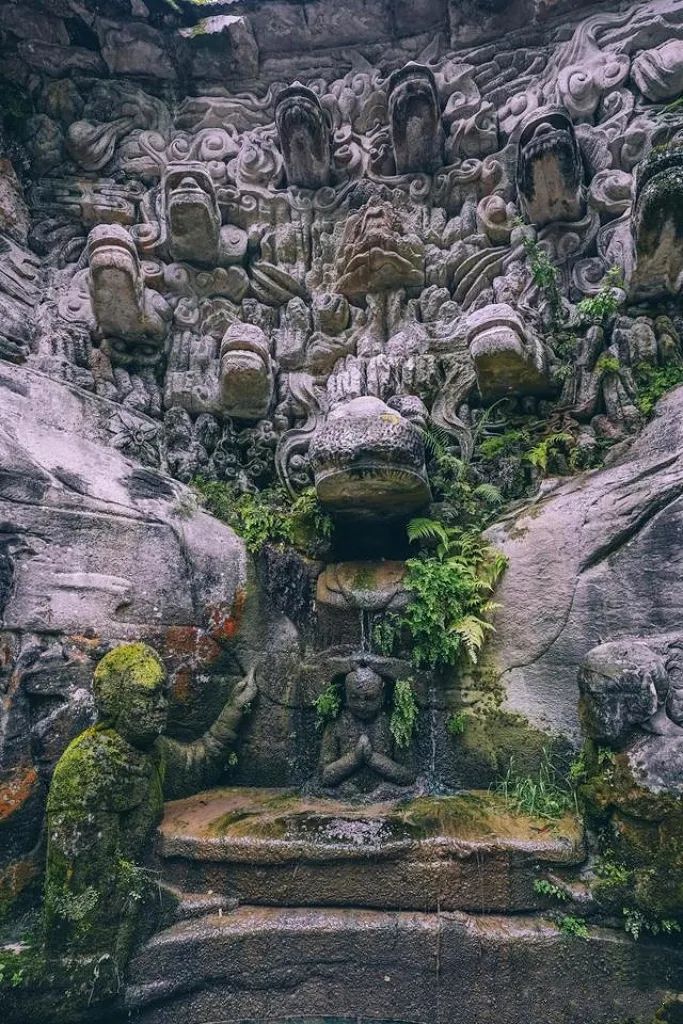
The Picture of the Nine Dragons Bathing the Prince
From the perspective of sculpture, this niche of statues is a masterpiece with unique ingenuity. From the perspective of engineering technology, it is also a model of adapting to local conditions. There used to be a gap here, where mountain water gathered and flowed continuously throughout the year. Instead of passively diverting the water elsewhere, the craftsmen first accumulated the water in the pond above the reclining Buddha, then built up the gap with stones, carved the nine dragons and the prince, and then through a hidden channel, made the water flow out slowly and moderately from the mouth of the largest dragon to bathe the newly born prince in the golden basin. The trickling water flowed over the prince’s body continuously for years. The craftsmen not only cleverly solved the drainage problem but also made the statues show movement within stillness, expressing the charm of garden landscapes.

Yuanjue Cave
There are two rather ingenious aspects about Yuanjue Cave. First, a hole was dug in the wall opposite the main Buddha to allow light to shine on the main Buddha and the Yuanjue Bodhisattvas kneeling and listening to the Dharma in front of the Buddha, which is extremely miraculous. Second, in terms of the design of the drainage system, the large alms bowl held by an old monk is used to receive the water flowing from the dragon’s head, and the other end of the water is diverted to above the old ox on the outer stone wall of the cave, just like the ox is drinking water. One has to marvel at the wisdom of the ancients. The whole cave mainly features the Twelve Yuanjue Bodhisattvas, with beautiful statues and magnificent decorations.
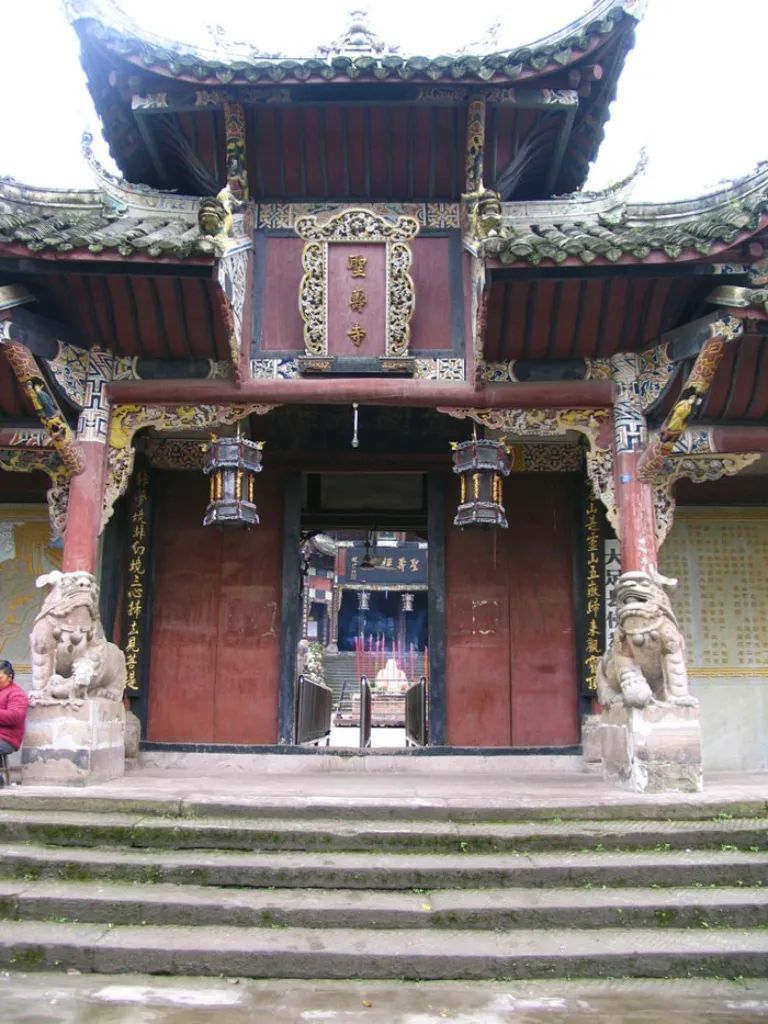
Shengshou Temple
It was first built in the third year of the Chunxi reign period of the Southern Song Dynasty, rebuilt in the eighth year of the Hongzhi reign period of the Ming Dynasty, and renovated in the thirty-second year of the Kangxi reign period of the Qing Dynasty. It is located at the right rear side of Dafowan on Baoding Mountain in Dazu District, Chongqing City, covering an area of 5,200 square meters. From west to east, there are the Holy Relic Pool, the Mountain Gate, the Hall of the Four Heavenly Kings, the Lingxiao Hall, the Mahavira Hall, the Hall of Dipankara Buddha, and the Vimalakirti Hall, all built according to the mountain terrain. Shengshou Temple is an Esoteric Buddhist Zen monastery built by Zhao Zhifeng, a prominent monk in the Southern Song Dynasty. It was originally called Wufoya and was 配套 with the rock carvings on Baoding Mountain. The Shengshou Temple in the Baoding Mountain scenic area was destroyed several times by wars. The existing temple buildings are from the Ming and Qing dynasties. Shengshou Temple is built against the mountain, with magnificent halls and exquisitely carved decorations. It had a booming incense business during the Ming and Qing periods, and there are still quite a number of pilgrims nowadays.
III. Beishan Rock Carvings
The Beishan Rock Carvings are an important part of the Dazu Rock Carvings. They were first carved by Wei Junjing, the prefect of Changzhou in the late Tang Dynasty and the commander-in-chief of the four prefectures of Chang, Pu, Yu, and He in 892 AD. There are nearly 10,000 cliff carvings on Beishan Mountain, and the Fowan is about half a kilometer long, with niches and caves as dense as beehives. It is famous for its exquisite and elegant style and is praised as the exhibition hall of the rock carving art of the Tang and Song dynasties. It is one of the first batch of key cultural relics protection units in China. In 1999, it was included in the “World Heritage List”. The niches of the Thousand-Handed Guanyin, the Sakyamuni Buddha, the Three Buddhas of the Past, Present and Future, and the Transformation of the Sutra of Contemplating the Buddha of Infinite Life are all its representative works, which 集中展示了 the development and changes of the artistic style of Bashu grottoes from the late Tang Dynasty to the Song Dynasty. The main attractions include: the Cave of the Peacock King Ming, the Niche of Marici, the Niche of the Thousand-Handed Guanyin on Beishan Mountain, the Cave of the Water Moon Guanyin, the Cave of the Revolving Sutra Repository, the Niche of the Transformation of the Sutra of Contemplating the Buddha of Infinite Life, the Duobao Pagoda, etc.
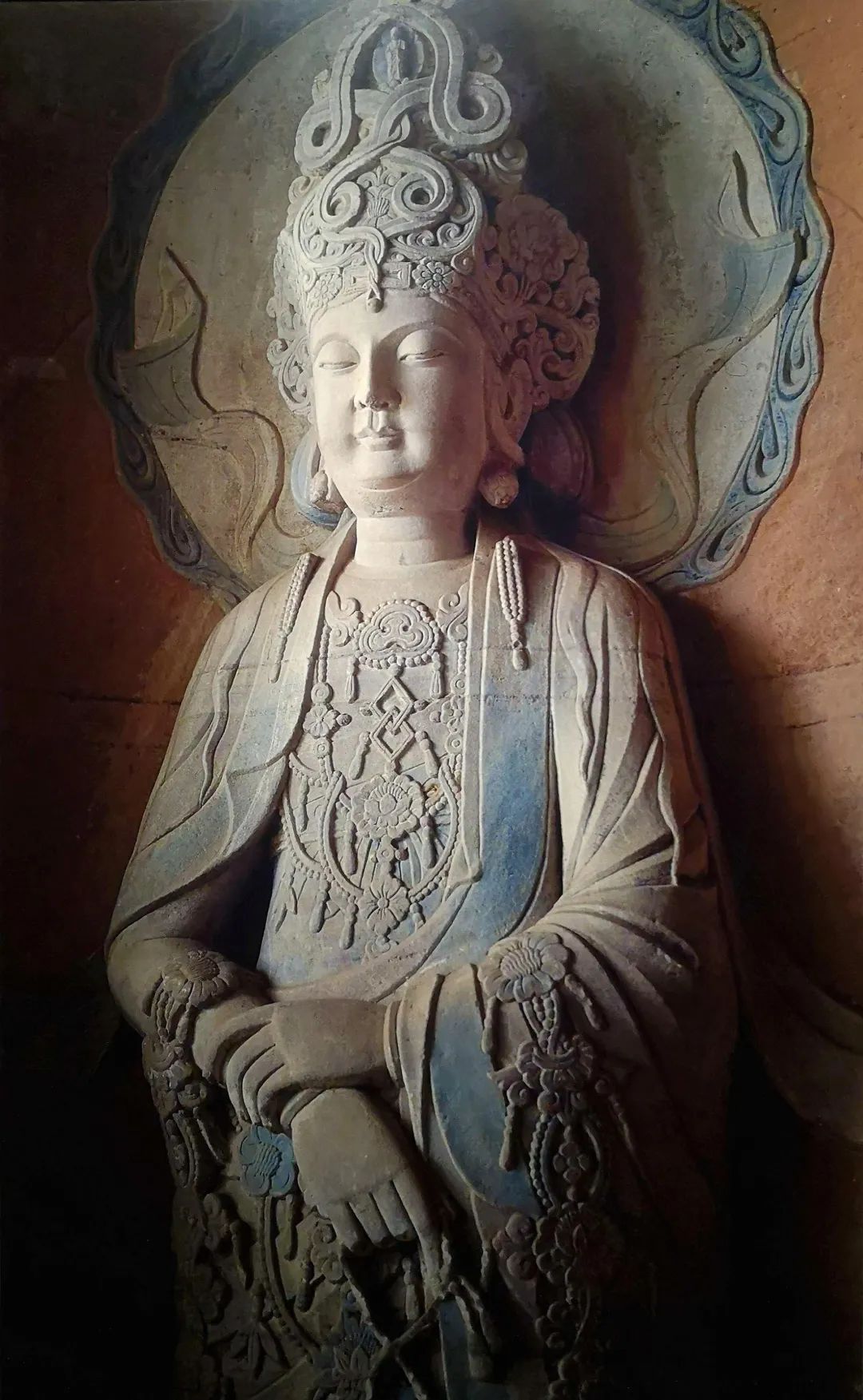
The Niche of the Rosary-Holding Guanyin
The Rosary-Holding Guanyin is one of the famous works of the Dazu Rock Carvings. She has a naive and shy expression, with affectionate and pensive looks, and her dress and skirt are gently fluttering in the wind, quite having the charm of “Wu’s ribbons fluttering in the wind”, and is affectionately nicknamed the “Graceful Guanyin”. The ribbons of Guanyin give a strong sense of “Wu’s ribbons fluttering in the wind”, being small yet exquisite.
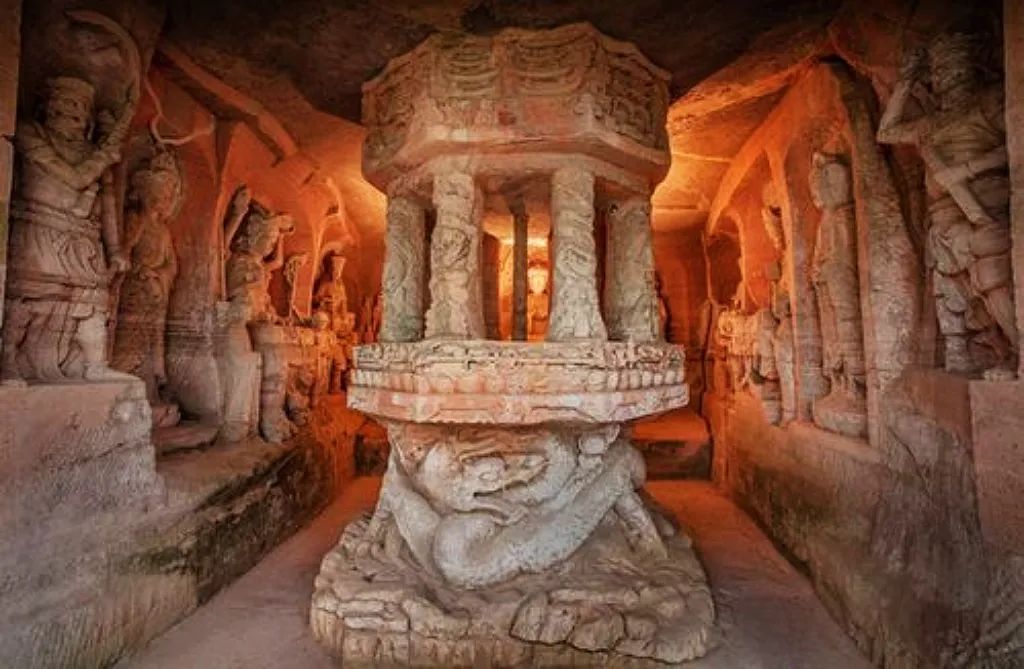
The Cave of the Revolving Sutra Repository
The Cave of the Revolving Sutra Repository was carved in the middle of Fowan on Beishan Mountain and is numbered 136. It is a large, flat-topped, rectangular cave. The cave is 4 meters high, 4.7 meters wide, and 7 meters deep. The statues have remarkable characteristics such as being preserved as good as new, having distinct personalities, and highlighting the national style. The Cave of the Revolving Sutra Repository was built in the Southern Song Dynasty. The Guanyin statues inside are elegant, beautiful, serene, and charming, showing an elegant, holy, and feminine beauty, reflecting the aesthetic taste of the Song people, and is 公认 as “a pearl on the crown of Chinese grotto art”.
The south wall (left wall) is carved with three groups of statues. From the inside to the outside, they are Manjushri Bodhisattva, the Jade Seal Guanyin, and the Wish-Granting Pearl Guanyin in turn. The north wall (right wall) is also carved with three groups of statues. From the inside to the outside, they are Samantabhadra Bodhisattva, the Sun and Moon Guanyin, and the Rosary-Holding Guanyin in turn. Personally, I think this is the most beautiful cave. There is a stone-carved revolving sutra repository standing in the middle. Different from that on Baoding Mountain, it is extremely simple and unsophisticated. What is worth seeing is the Sun and Moon Guanyin, the second statue on the left side, which has a Tang Dynasty style, with a face as smooth as creamy jade, and both the crown and the pearl necklace are very exquisite. The Manjushri Bodhisattva on the innermost left side wears a square crown and is praised as the “Eastern Beauty God”, full of charm.
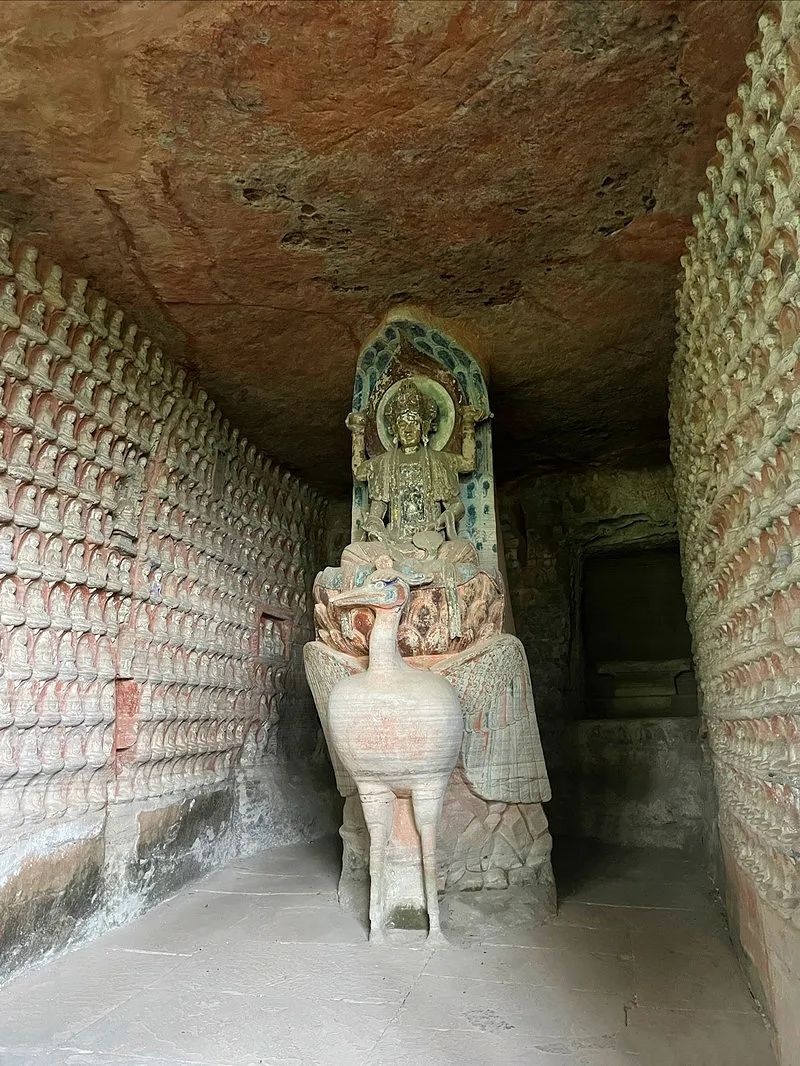
The Cave of the Peacock King Ming
The Cave of the Buddha Mother Peacock King Ming is a classic work among the Beishan Rock Carvings in Dazu. There are as many as 950 statues in the whole cave. In the cave, the peacock stands upright, and the Peacock King Ming sits cross-legged on the lotus pedestal carried by the peacock’s back. More than 900 small Buddhas are carved on both walls, all sitting cross-legged on lotus seats, which is very spectacular. The Peacock King Ming has four arms. The upper left hand holds a scripture, the lower left hand grasps a fan and places it in front of the abdomen, the upper right hand holds a wish-granting pearl, and the lower right hand holds a peacock feather and places it on the knee. The peacock spreads its wings as if it is about to fly, with its tail cocked up, reaching the top of the cave from behind the main statue and then bending forward over the head of the main statue to form the backlight behind it and also playing a role in supporting the top of the cave.
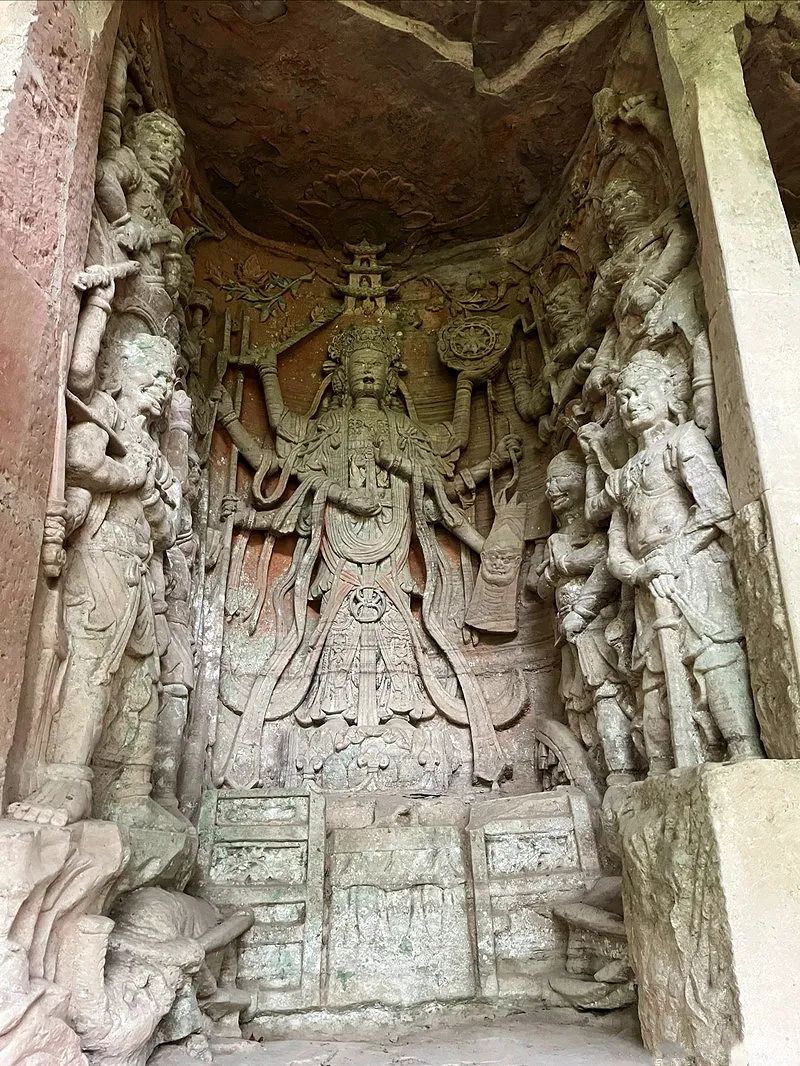
The Niche of Marici
It is a rather special niche. It is relatively rare to see her as the main deity with a separate niche. The carving is fine, and the ribbons seem to be able to flutter with the wind. The Heavenly Kings and Mighty Warriors on the side walls are also very vivid.
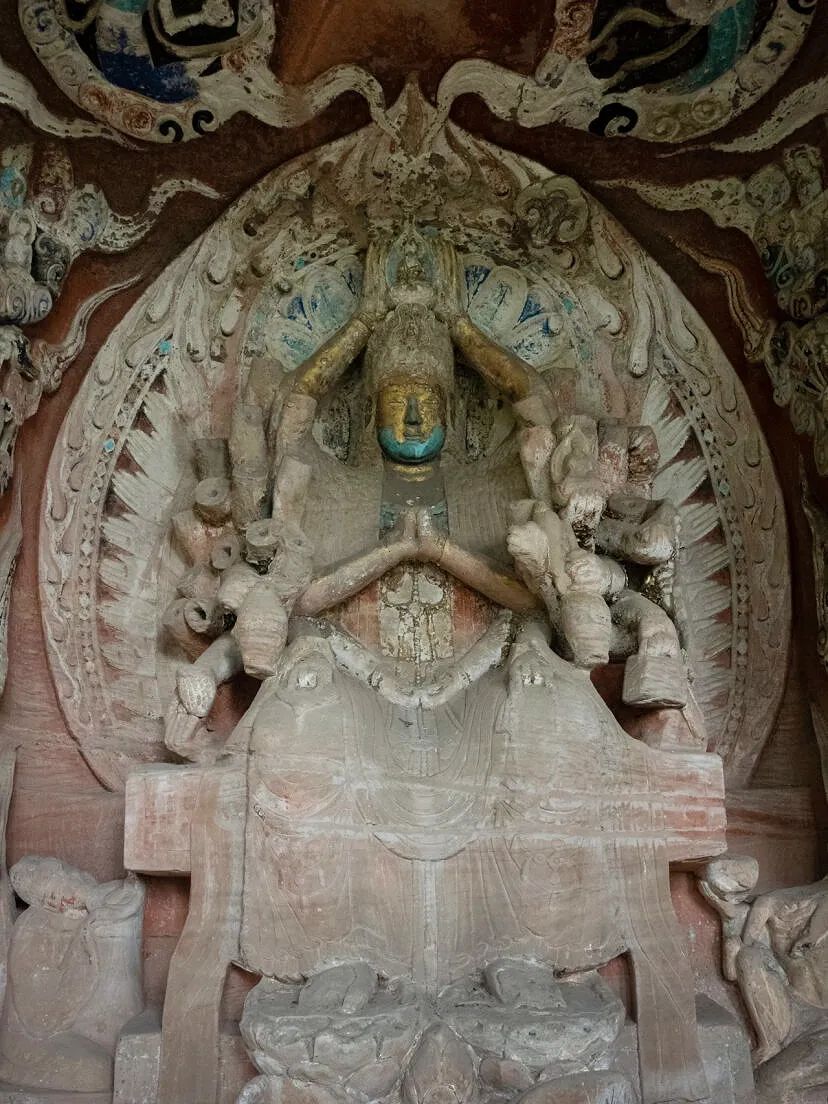
The Niche of the Thousand-Handed Guanyin
Compared with the Thousand-Handed Guanyin in the Baoding Mountain Rock Carvings, this Thousand-Handed Guanyin statue undoubtedly has far fewer “hands”. Forty-four hands are symmetrically carved on the left and right sides, and twenty hands are carved in the peach-shaped flame-patterned backlight behind it. Many of the hands are damaged and the palms are missing, but the remaining gold foil and colors can still give a glimpse of its former exquisiteness. There are two flying apsaras on the top of the niche, which are well preserved and look rather “lovely”. On the uppermost and innermost layers of the two walls, five Buddhas sitting in auspicious clouds are symmetrically carved, and together they are the Ten Directions Buddhas. On the outer side of the left wall are those surrounding the twelve-sided drums, those holding fans, and those holding ropes. At the symmetrical position on the right wall is a figure holding a large bag standing in the auspicious clouds, who are the Four Gods of Wind, Rain, Thunder, and Lightning. On the inner side of the second layer of the left wall is the Peacock King, and beside it is Manjushri sitting on a blue lion. There are also poor ghosts and hungry ghosts below the Guanyin statue. This Guanyin niche has rich contents and exquisite carvings and can definitely be regarded as one of the fine works among the Beishan Rock Carvings.
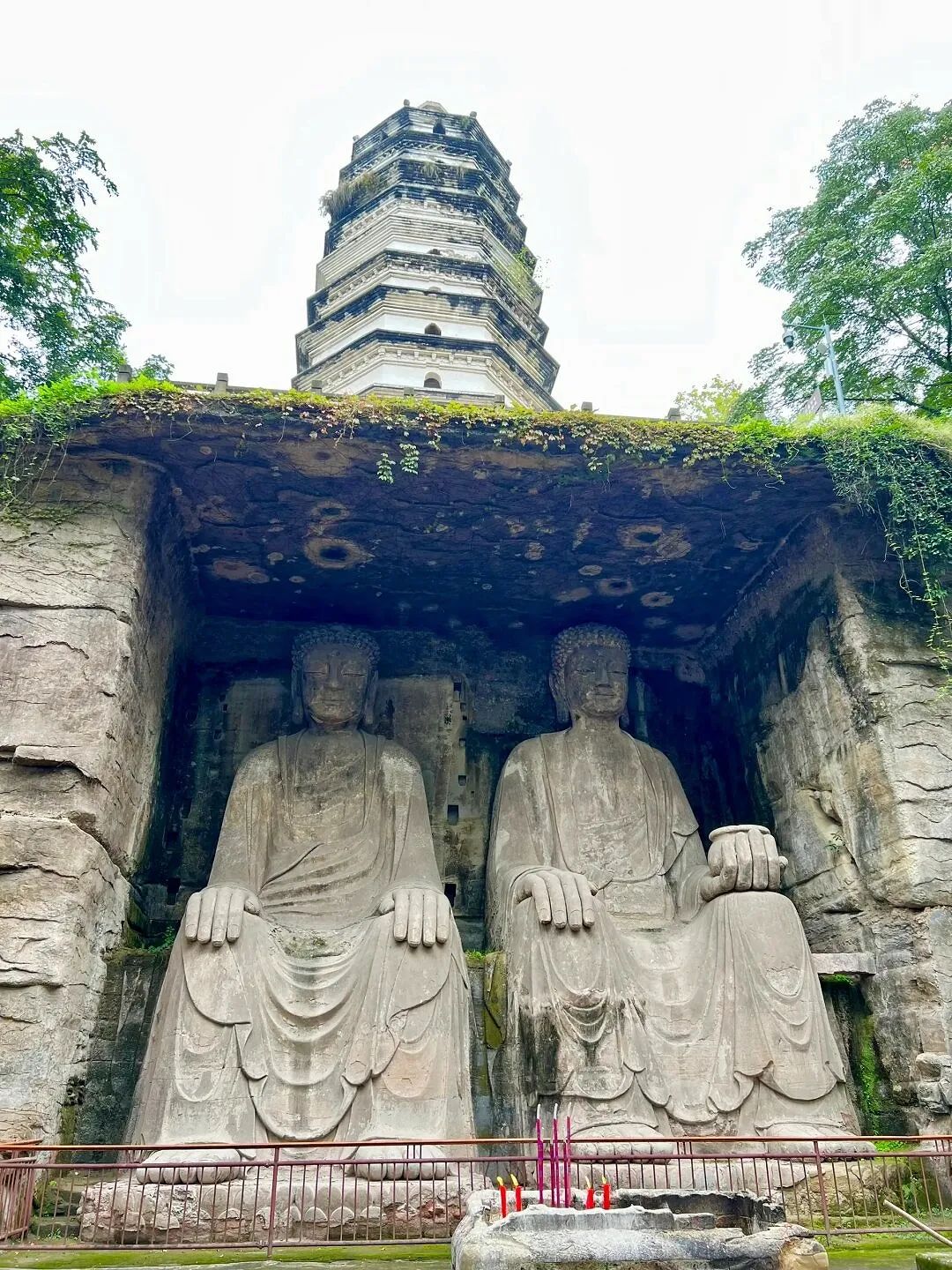
The Duobao Pagoda on Longgang Mountain
It is located on Longgang Mountain in Dazu District, Chongqing City. It is 33 meters high, with a side length of 4 meters at the bottom layer. It is an octagonal brick pagoda with thirteen stories in the pavilion style, with each layer gradually narrowing inward. There are 8 layers inside, and stairs can lead to the top of the pagoda. Each layer is equipped with a pagoda chamber. There are a total of 127 niches of statues both inside and outside. At the foot of the pagoda, on the mountain body, the statues of the Two Buddhas Sitting Side by Side are carved. They are 9.64 meters high and 3.98 meters wide at the shoulders. The left one is the Prabhutaratna Buddha, and the right one is the Sakyamuni Buddha.
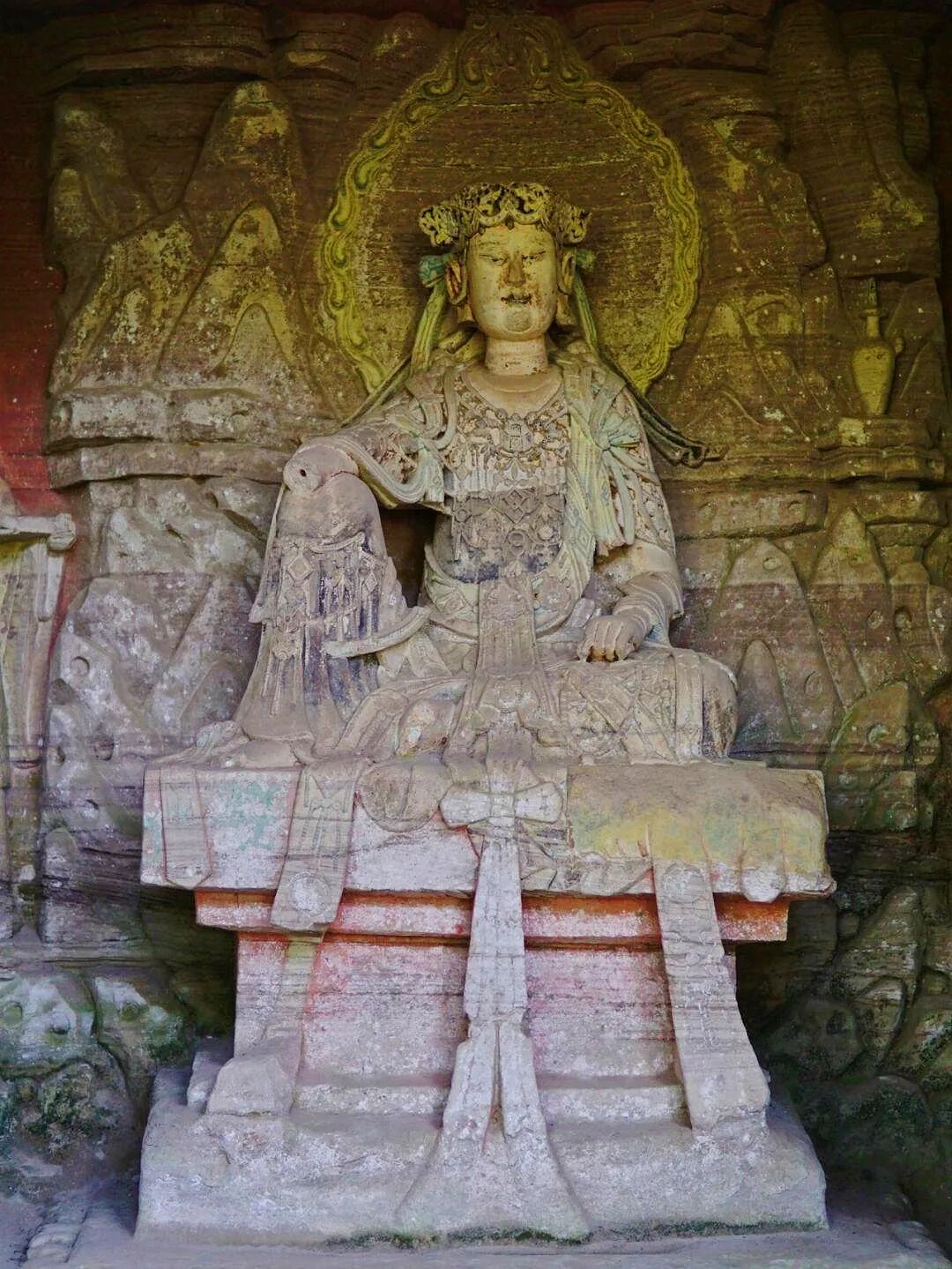
The Cave of the Water Moon Guanyin
The Water Moon Guanyin is also called the “Cross-legged Guanyin” in the Sichuan-Chongqing region. It gets its name because of its free and easy sitting posture, with one foot “crossed and sitting playfully”. This Water Moon Guanyin has a mountain rock behind it and a flame-patterned backlight. On the left and right sides are the statues of Sudhana and the Dragon Girl. The four Heavenly Kings are carved on the left and right walls. Wearing a flower crown on the head, with the right leg lifted and the left leg naturally crossed and sitting, the sitting posture is very casual and elegant. There are ribbons all over the body, flower clusters and bead strings, and the decorated pearl necklaces are especially delicate and complicated, which are obvious characteristics of the Song Dynasty statues, with a strong decorative flavor. Moreover, the expressions and postures of the statues also have their own characteristics, giving people a sense of distinct individuality, which is also a manifestation of the secularization of the Buddha statues in the Song Dynasty. During this period, the Buddha statues were closer to human expressions, having more “humanity” instead of “divinity”.
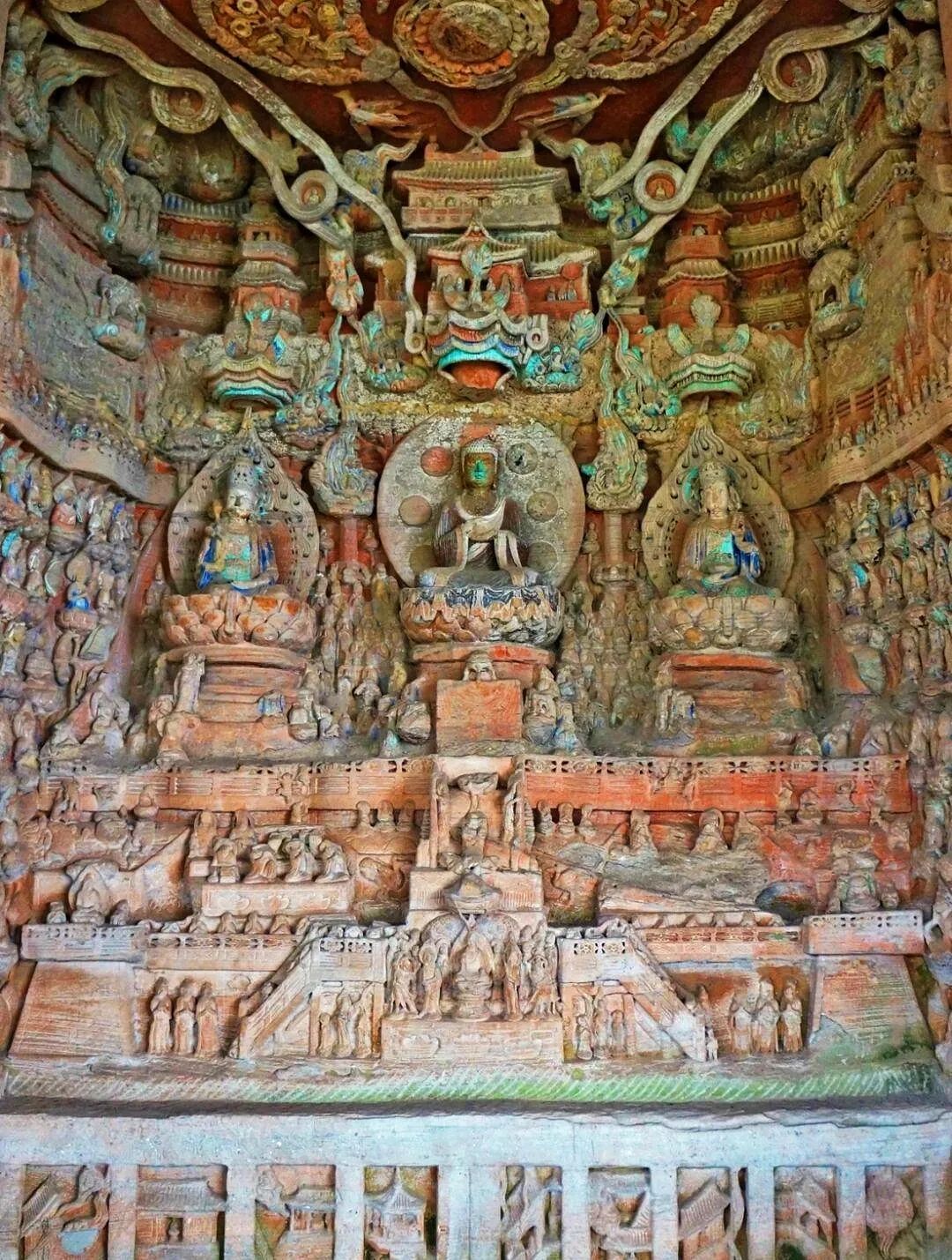
The Niche of the Transformation of the Sutra of Contemplating the Buddha of Infinite Life
The Niche of the Transformation of the Sutra of Contemplating the Buddha of Infinite Life on Beishan Mountain in Dazu in the late Tang Dynasty has 578 statues and 42 scripture pillars and pavilions carved in the whole group of stone carvings, demonstrating the superb carving skills in the late Tang Dynasty. The combined niche of the Guanyin statue and Ksitigarbha in the Five Dynasties interprets the evolving style of the statues from the Tang Dynasty to the Song Dynasty during the Five Dynasties.
IV. Nanshan Rock Carvings
The Nanshan Rock Carvings are a rare Taoist grotto sanctuary. The Nanshan Rock Carvings are located on the top of the picturesque Nanshan Mountain. There is a temple on the top of the mountain called the Yuhuangguan. The scenery is quiet and secluded, with bamboo groves lining the paths, lush forests and green trees surrounding it. Literati and poets have always come here to enjoy the cool, drink tea, chant poems and respond to each other, so it has the elegant name of “The Green Screen of Nanshan”. Along the cliff walls, niches and caves such as those of the True Martial Emperor, the Three Holy Mothers, and the Dragon Cave are carved respectively towards the east and west. Besides the statues, the inscriptions on steles from the Song, Ming, and Qing dynasties in Nanshan also have extremely high artistic value in calligraphy.
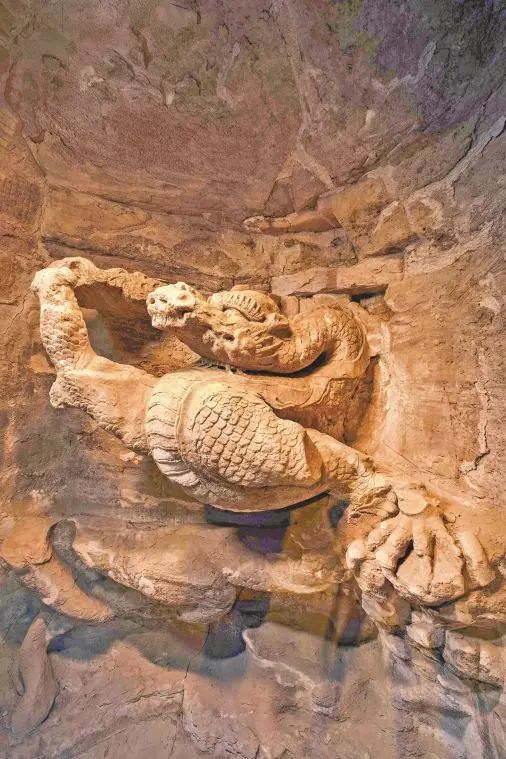
The Dragon Cave
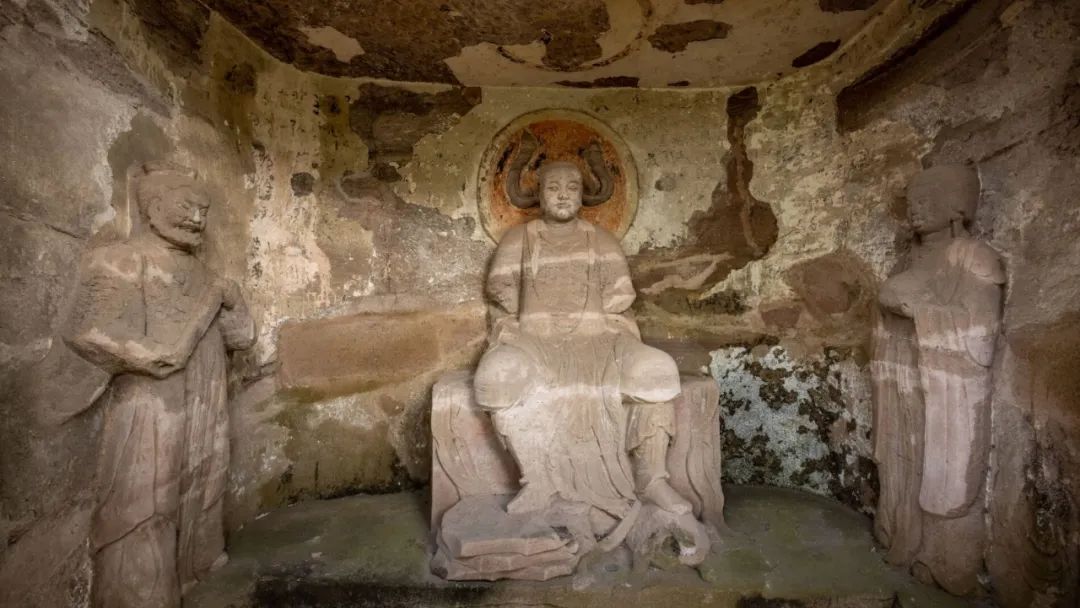
The Niche of the True Martial Emperor on Nanshan Mountain
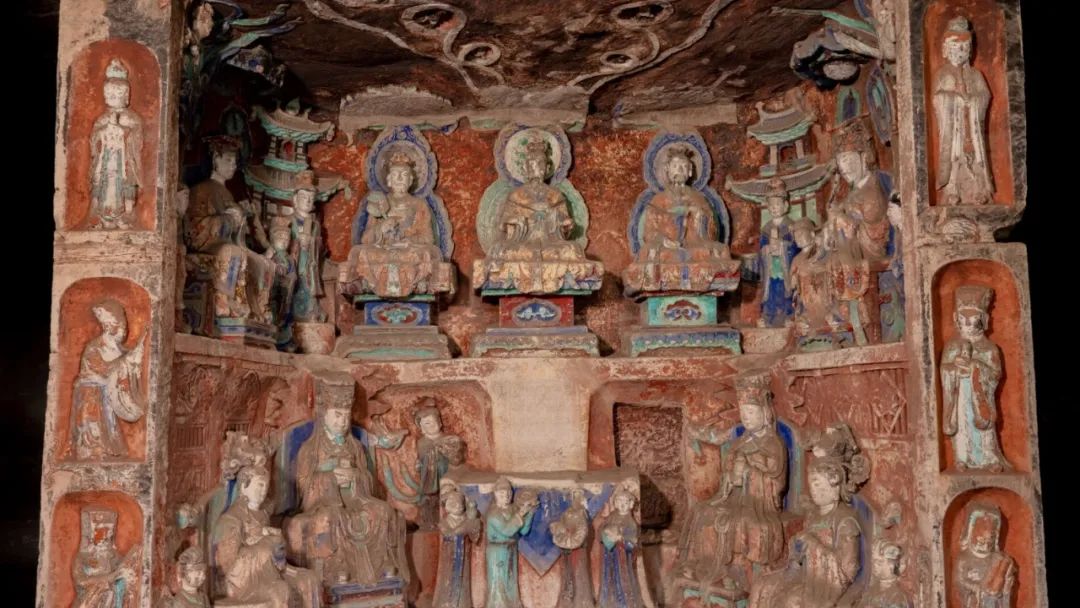
The Sanqing Cave on Nanshan Mountain
What visitors should not miss when they come here is its “treasure of the mountain” – the Sanqing Cave. This cave is a central pillar cave, which is rare among the Dazu Rock Carvings. There is a vertical square central pillar in the middle of the cave, and corridors are formed around it.
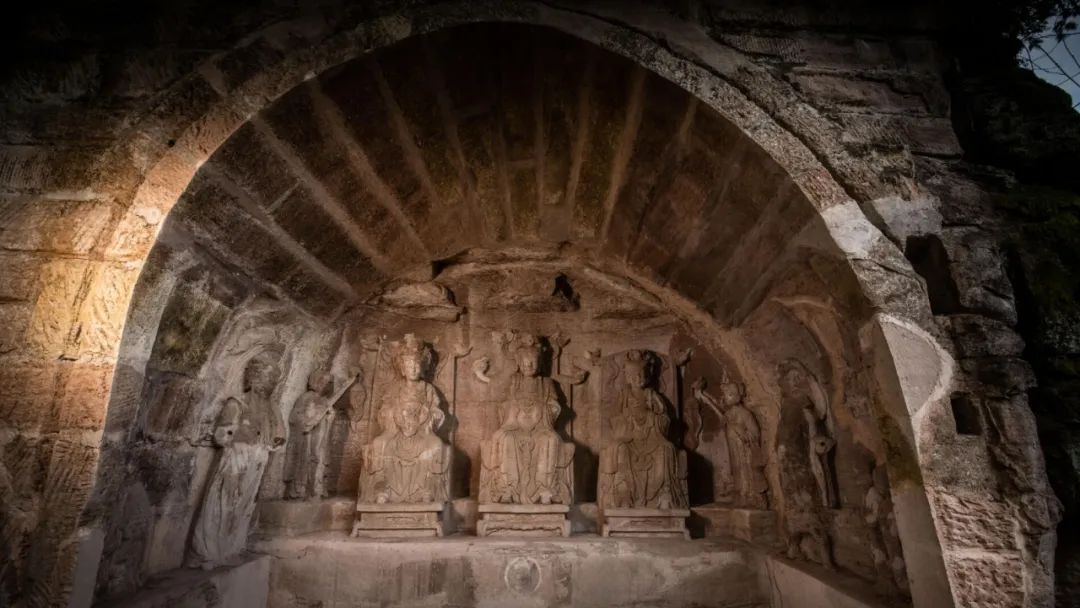
The Niche of the Empress of Earth for Childbearing on Nanshan Mountain
V. Shimen Mountain Rock Carvings
The Shimen Mountain Rock Carvings are an art treasure house where Buddhism and Taoism blend together. The statues are arranged on the cliff walls of three relatively independent rock masses on the east, west, and south sides of the mountain top, with a total of 22 numbered niches. This is an area where Buddhist and Taoist statues are combined, and the Taoist statues are especially distinctive. Therefore, in the ninth year of the Chunxi reign period (1182), Deng Cheng wrote in the “Stele of Shimen Cave”: “The statues have no fixed forms. They may be immortals, Buddhas, or various ghosts and gods, changing in thousands of ways and mixed in one area.”
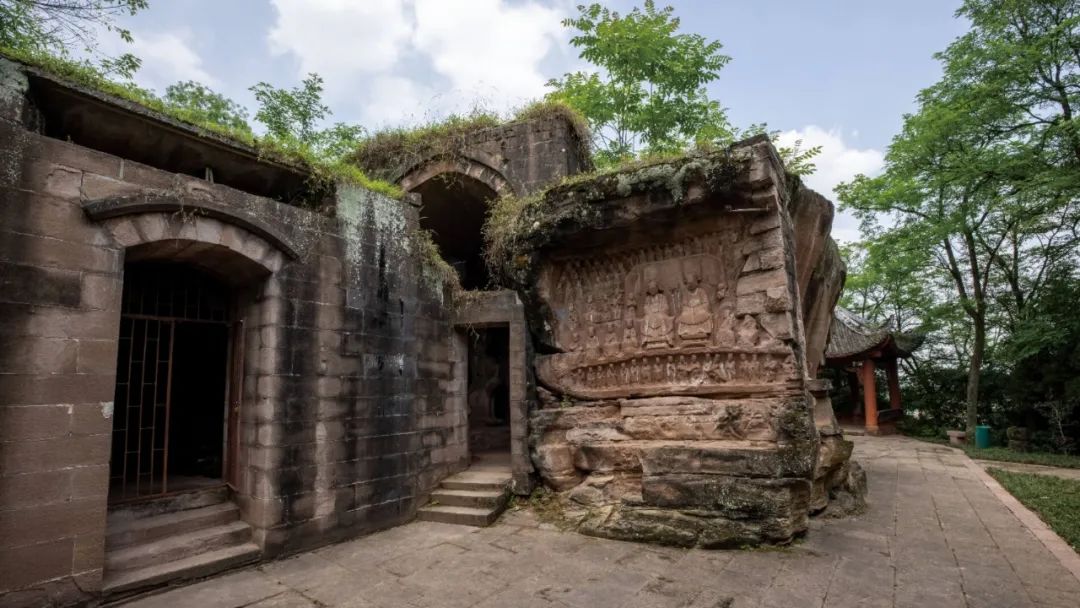
Shimen Mountain Rock Carvings
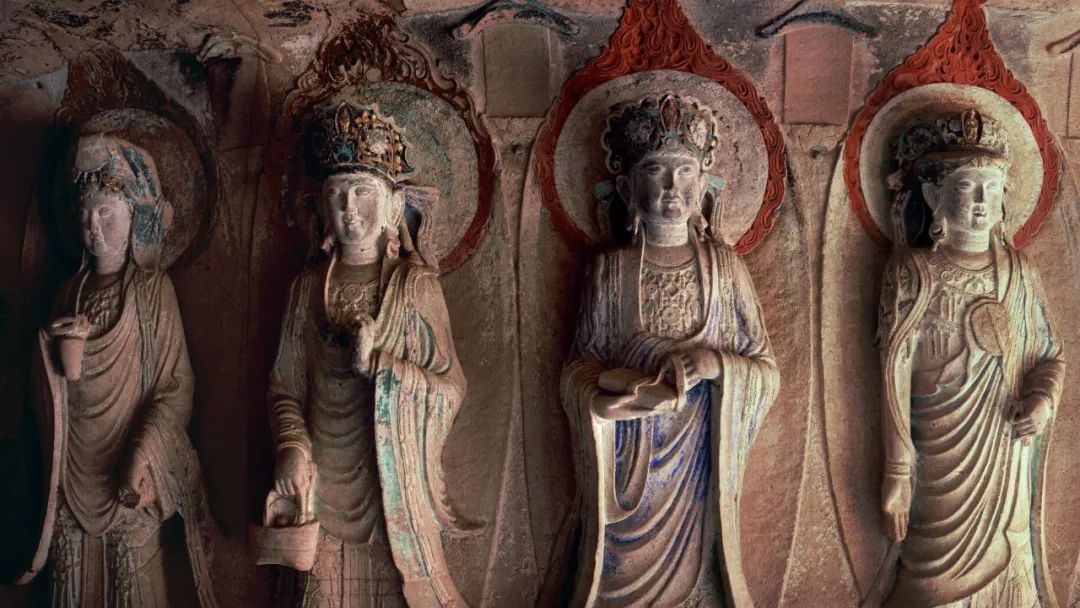
Shimen Mountain Cave of the Western Three Sages and Ten Holy Guanyins (Partial)
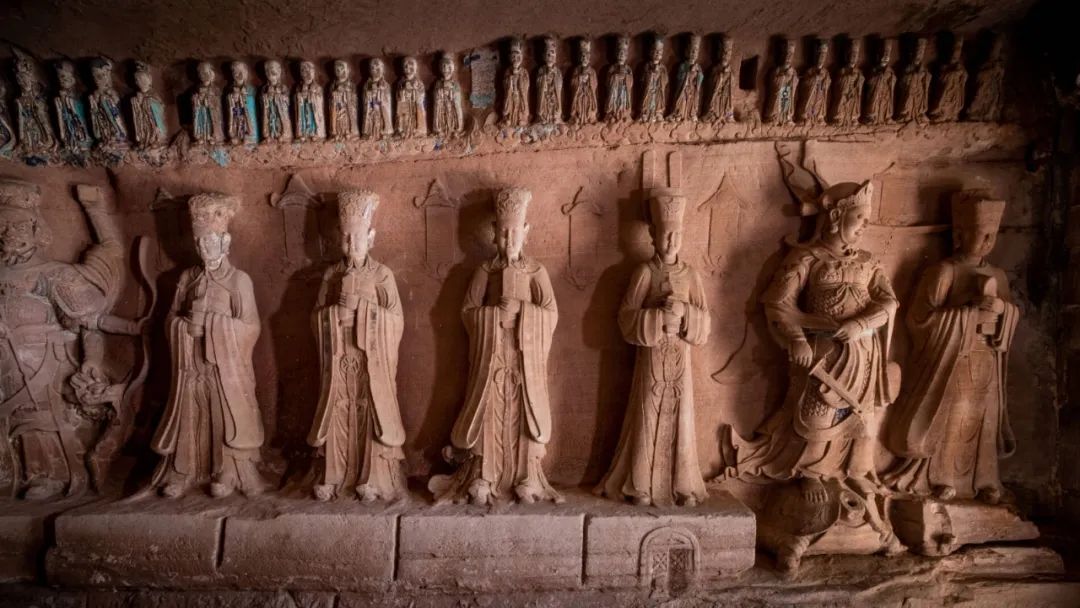
Shimen Mountain Sanhuang Cave (Partial)
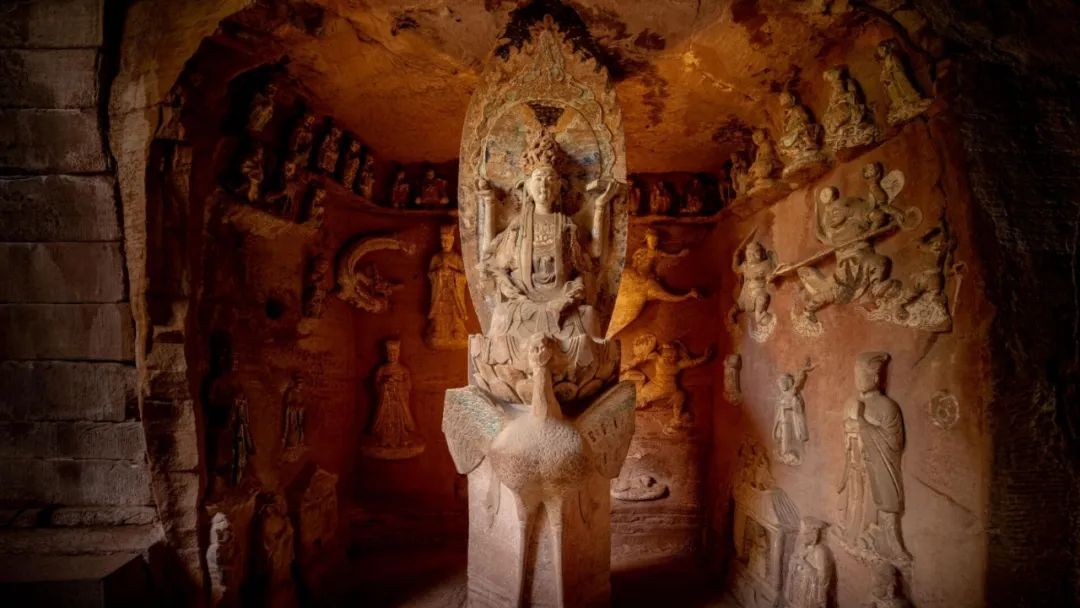
Shimen Mountain Cave of the Peacock King Ming in Transformation
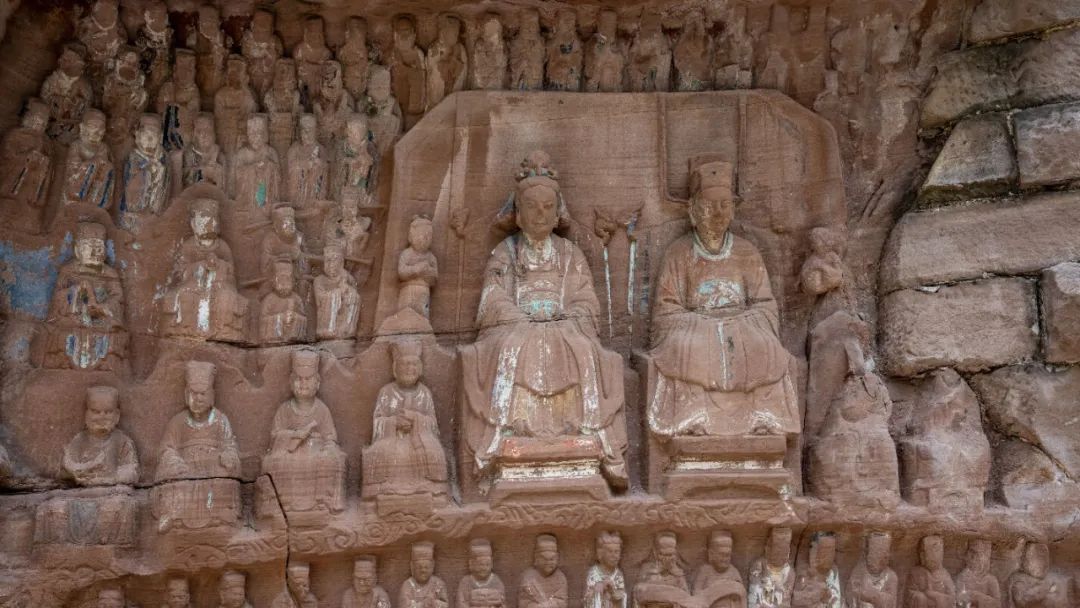
Shimen Mountain Niche of the Dongyue Great Emperor and Empress Shuming
VI. Shizhuan Mountain Rock Carvings
The Shizhuan Mountain Rock Carvings are a model of grottoes that integrate Confucianism, Buddhism, and Taoism. The statues are a typical area where the “Three Teachings” of Buddhism, Taoism, and Confucianism are worshipped together. Near the grottoes, there are also stone pagodas, cliff carvings, and steles. On the top of the mountain, the Fohui Temple was built. The existing “Fohui Temple” building was rebuilt during the Yongle reign period of the Ming Dynasty after being damaged by war in the Yuan Dynasty. Picture Behind each statue, there is a unique story. Having gone through thousands of years, it is like a gaze across time between history and us.
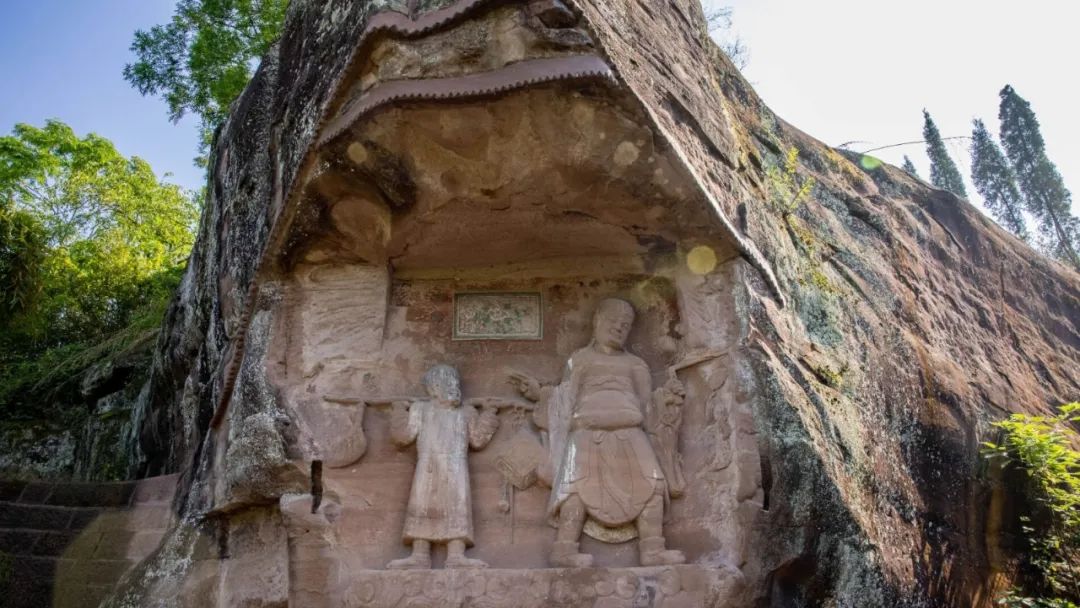
Shizhuan Mountain Niche of Monk Zhigong
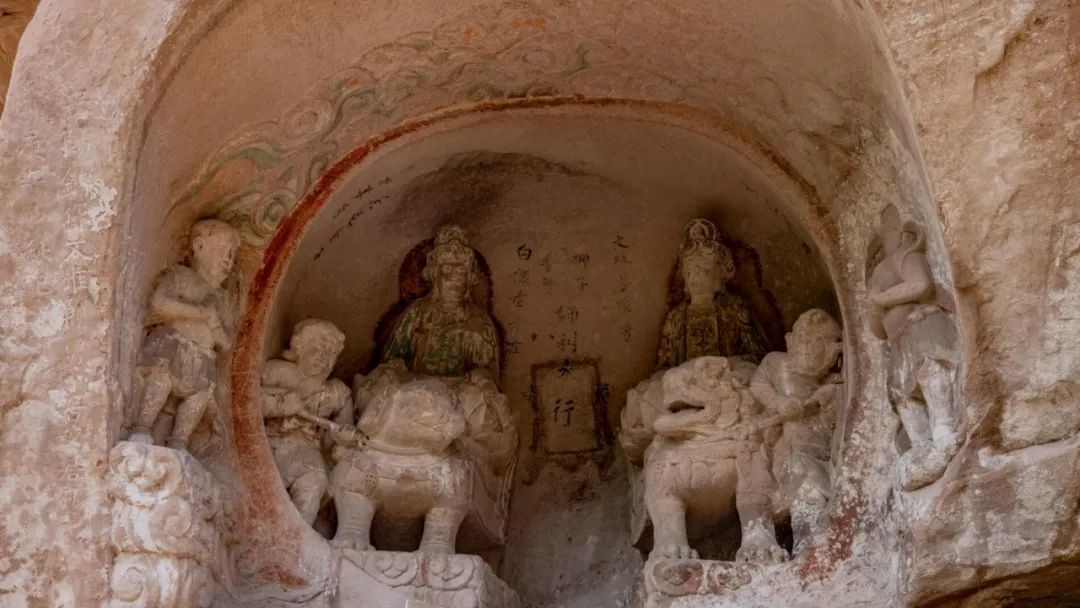
Shizhuan Mountain Niche of Manjushri and Samantabhadra
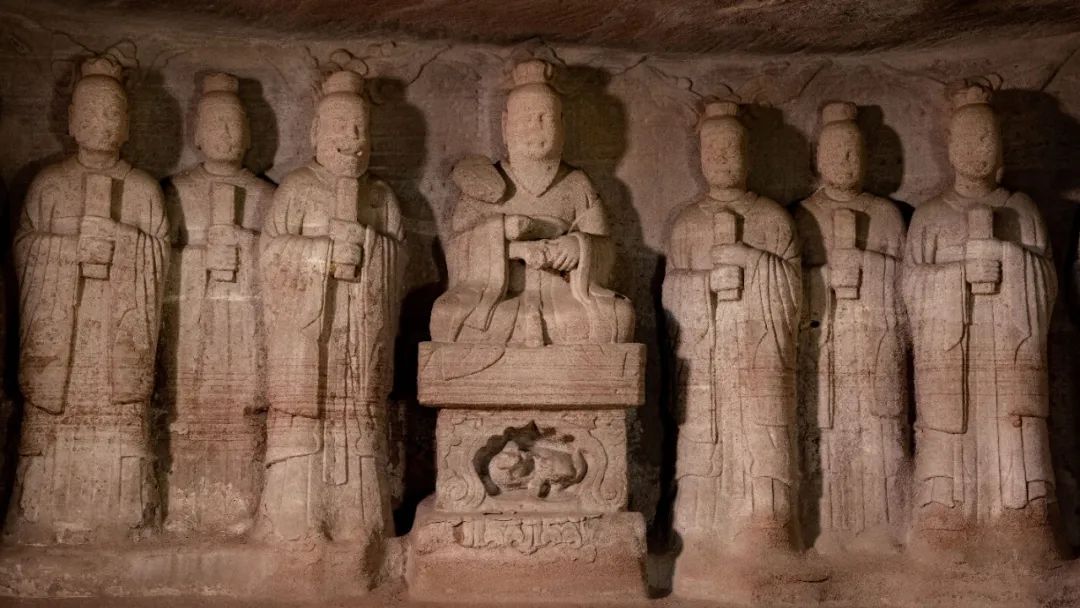
Shizhuan Mountain Niche of the Supreme Lord Laozi
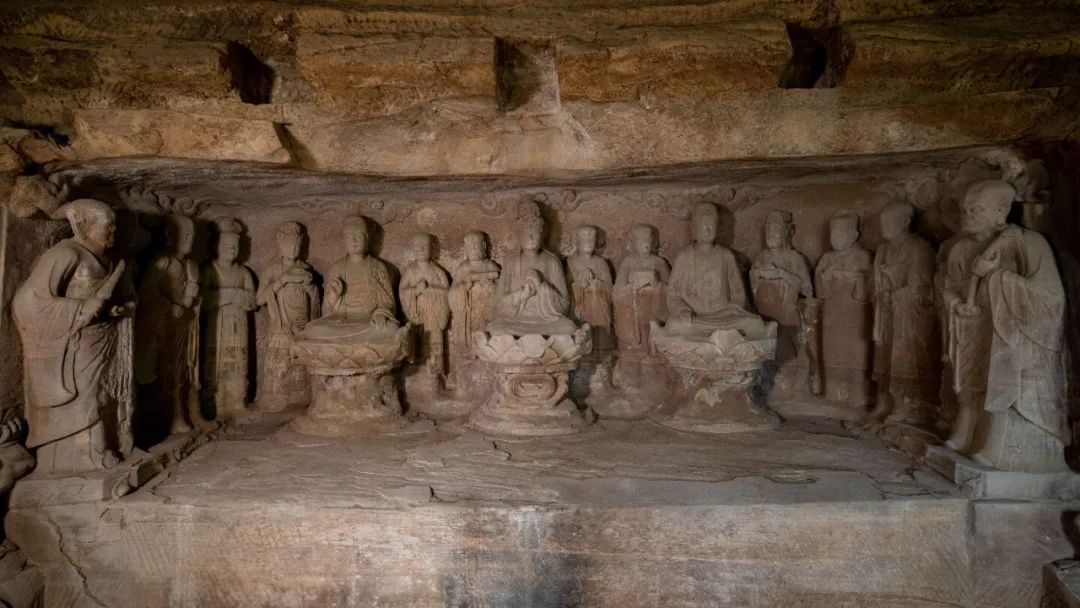
Shizhuan Mountain Niche of Vairocana, Sakyamuni, and Maitreya

Shizhuan Mountain Niche of Hariti
VII. Opening Hours of the Scenic Area
Opening Hours:
For Baoding Mountain and Beishan Rock Carvings: 08:30 – 18:00 (Entry stops at 17:00).
For Nanshan, Shimen Mountain, and Shizhuan Mountain Rock Carvings: 09:00 – 17:30 (Entry stops at 16:30).
Ticket Prices of the Scenic Area:
Low Season: From December 1st each year to February 28th/29th of the following year. High Season: From March 1st to November 30th each year.
For Baoding Mountain Scenic Area (including Shengshou Temple): ¥100.00 in the low season; ¥115.00 in the high season.
For Beishan Scenic Area: ¥50.00 in the low season; ¥70.00 in the high season.
For the combined ticket of Baoding Mountain and Beishan Scenic Areas: ¥120.00 in the low season; ¥140.00 in the high season.
For Nanshan Rock Carvings Scenic Area (single ticket): ¥30.00.
For Shimen Mountain Rock Carvings Scenic Area (single ticket): ¥30.00.
For Shizhuan Mountain Rock Carvings Scenic Area (single ticket): ¥30.00. Picture Picture There are 4 ways to visit the Dazu Rock Carvings.
VIII. Transportation in the Scenic Area
By Bus: Depart from the main urban area of Chongqing and arrive at Dazu Bus Station – Take Bus No. 205 or a taxi – Reach the Dazu Rock Carvings Visitor Center (Bus tickets can be purchased at any station of the Chongqing Highway Passenger Station).
By Train/High-Speed Rail: Arrive at Dazu South Station – Take Bus No. 204 (get off at the Telecom Bureau Station) / Bus No. 206 (get off at the Hongsheng Square Station) – Take Bus No. 205 (board at the Telecom Bureau Station) / the Rock Carvings Special Line Bus No. 2015 (board at the Hongsheng Cultural Square Station) / Take a taxi – Reach the Dazu Rock Carvings Visitor Center.
By Plane: Arrive at Chongqing Jiangbei Airport – Go to the Chongqing Airport T2/T3 Long-Distance Bus Station – Reach Dazu Bus Station – Take Bus No. 205 or a taxi – Reach the Dazu Rock Carvings Visitor Center.
Self-Driving Tour: Navigate to the Dazu Rock Carvings Scenic Area. Take the G5013 Chongqing-Chengdu Expressway – Exit at Dazu East / Dazu West – Take Baotang Avenue – Reach the Dazu Rock Carvings Visitor Center.

Location Map of the “Five Mountains” in Dazu Rock Carvings Scenic Spots
IX. Recommended Tour Routes
One-Day Tour: Baoding Mountain Rock Carvings – Dazu Rock Carvings Museum.
Two-Day Tour: Day 1: Baoding Mountain Rock Carvings; Day 2: Beishan Rock Carvings, Shizhuan Mountain.
Three-Day Tour: Day 1: Baoding Mountain Rock Carvings; Day 2: Beishan Rock Carvings; Day 3: Shizhuan Mountain, Chongqing Dazu Rock Carvings Museum.
X. Precautions
There are many mountain roads in the Dazu Rock Carvings Scenic Area. It is recommended to wear comfortable shoes.
There is plenty of sunlight in the scenic area. Pay attention to sun protection.
The rock carvings are precious cultural relics. Please do not touch or climb them.
Here are some additional travel tips:
The best seasons to visit the Dazu Rock Carvings Scenic Area are spring and autumn when the weather is cool and comfortable.
There is a tour guide interpretation service in the scenic area. You can hire a tour guide for a fee.
There are restaurants and shops in the scenic area that can provide catering and shopping services.
The Dazu Rock Carvings are quite far from the main urban area of Chongqing. It is recommended to book accommodation in advance.